How to Grow Borage: A Comprehensive Guide to Planting, Care, and Uses
- March 26, 2024
- 0 comment
Learn how to grow Borage, or Borago officinalis, a versatile herb celebrated for its vivid blue flowers and cucumber-esque flavor. This guide will walk you through the process of growing this annual herb, which is not only a culinary gem but also a gardener’s ally in attracting pollinators and enhancing soil quality. Discover the key steps to nurturing borage in your garden and enjoy its multitude of benefits.
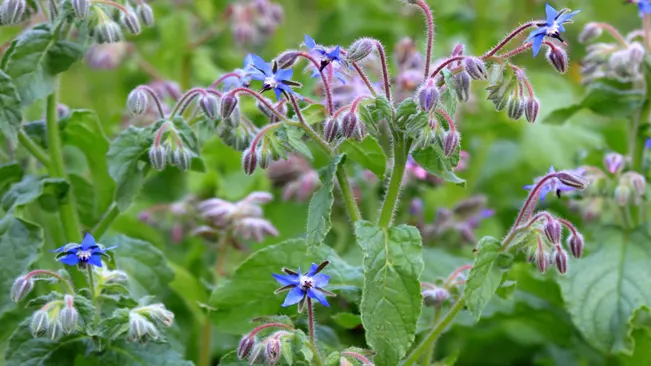
List on How To Grow Borage
- Choosing a Location
- Soil Preparation
- Planting
- Watering
- Feeding
- Pruning and Maintenance
- Pest and Disease Control
- Harvesting
- Benefits in the Garden
Choosing a Location
Borage thrives in well-drained soil and full sun. It prefers a sunny spot but can tolerate partial shade. The area should be easily accessible for regular watering and harvesting.
Sunlight and Shade Balance
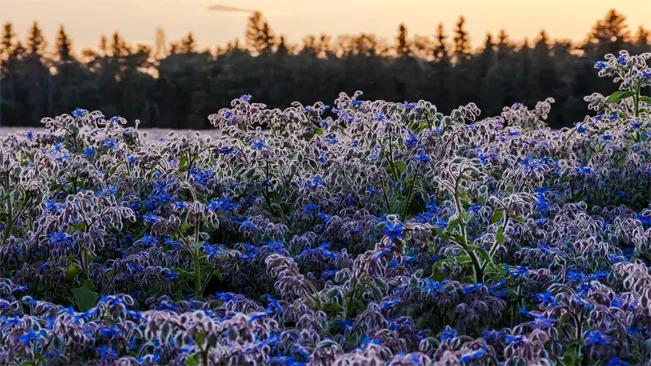
- Borage is a sun-loving plant and does best in locations where it can receive full sunlight for most of the day. Ideally, this means about 6 to 8 hours of direct sunlight. However, it can also tolerate partial shade, especially in hotter climates where the afternoon sun might be too intense. In partial shade, borage might not grow as vigorously or bloom as profusely, but it will still produce its distinctive leaves and flowers.
Accessibility for Maintenance
- When choosing a location, think about the ease of access for regular garden chores. Borage will need consistent watering, especially during dry spells, so a location that’s easy to reach with a hose or watering can is ideal. Additionally, since borage can grow quite large and bushy, ensure there’s enough space around the plant for you to move comfortably for maintenance, harvesting, and monitoring plant health.
Microclimate Considerations
- Be aware of your garden’s microclimate. Areas near walls or fences might get extra warmth from reflected heat, which borage generally appreciates. However, if you’re in a very hot climate, a spot that gets some afternoon shade could be beneficial to prevent stress from excessive heat.
Companion Planting
- If you’re practicing companion planting, place borage near plants it benefits, like tomatoes, strawberries, or squash. Borage is known to deter certain pests and can attract beneficial pollinators, making it an excellent neighbor in a mixed vegetable or herb garden.
Soil Preparation
Borage is not particularly fussy about soil but grows best in a soil enriched with organic matter. Ensure the soil is loose and well-draining. You can improve soil quality by adding compost or aged manure.

- Organic Matter: Borage benefits greatly from soil enriched with organic matter. Organic matter improves soil structure, enhances nutrient content, and helps retain moisture – all of which contribute to healthier borage plants.
- Drainage: Good drainage is crucial for borage. Waterlogged soil can lead to root rot and other fungal diseases. While borage needs moist soil, it should not be so wet that water stands for prolonged periods.
- Soil Texture: Loamy soil is ideal for borage. It should be loose enough to allow roots to grow freely and access nutrients and water. Hard, compacted soil can hinder root development.
How to Prepare the Soil
- Testing the Soil: Before adding anything, it’s beneficial to test your soil’s pH and nutrient levels. Borage prefers a pH that is neutral to slightly acidic. Soil tests can guide you on how to adjust the soil composition, if necessary.
- Incorporating Organic Matter
- Compost: Adding well-decomposed compost is one of the best ways to enrich the soil. Compost provides a balanced range of nutrients and improves soil structure.
- Aged Manure: If available, aged manure (especially from herbivores like cows or horses) is a great addition. It should be well-rotted to avoid burning the plants with too much nitrogen.
- Improving Drainage
- If your garden has heavy clay soil, incorporate sand or gravel along with organic matter to improve drainage.
- In very sandy soil, adding organic matter helps retain enough moisture for the plants.
- Tilling the Soil: Loosen the soil to a depth of about 12-15 inches. This aeration is crucial for the healthy growth of borage. It allows the roots to penetrate deeply and the soil to drain efficiently.
- Adding Fertilizers: Generally, borage does not require heavy fertilization. If your soil test indicates a deficiency, a balanced, all-purpose organic fertilizer can be added. However, be cautious not to over-fertilize, as too much nitrogen can reduce flowering.
Planting
Borage seeds can be directly sown in the garden. Plant the seeds after the danger of frost has passed, in late spring or early summer. Sow the seeds 1/4 to 1/2 inch deep and space them about 12 inches apart. Borage can also be started indoors and then transplanted, but it prefers to grow where it is sown.
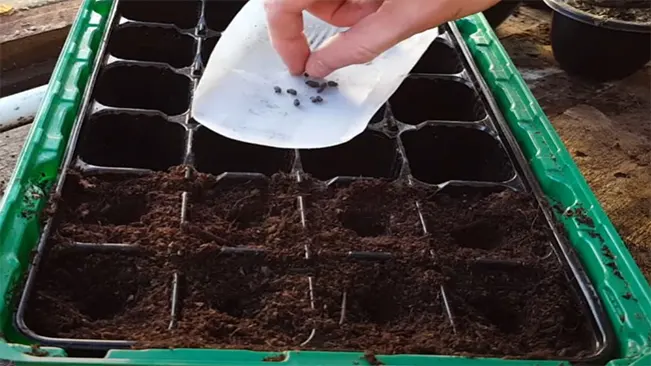
Direct Sowing in the Garden
- Timing: Borage seeds should be planted after the last frost date in your region, typically in late spring or early summer. This timing is crucial as borage seeds require warmer soil temperatures for optimal germination.
- Seed Depth: Plant borage seeds at a depth of about 1/4 to 1/2 inch. This shallow planting allows for sufficient light exposure and easier emergence of seedlings.
- Spacing: Space the seeds or seedlings about 12 inches apart. Borage plants tend to spread out as they grow, and adequate spacing is necessary to prevent overcrowding and ensure healthy growth.
- Watering after Planting: After sowing, water the soil gently but thoroughly. The soil should be kept consistently moist but not waterlogged to encourage germination.
- Germination Time: Borage seeds typically germinate within 5 to 15 days, depending on soil temperature and conditions. Warmer soils will speed up the germination process.
Starting Indoors
- Early Start: If you choose to start borage seeds indoors, begin about 3-4 weeks before the last expected frost. This head start can be beneficial if you live in a region with a short growing season.
- Containers and Soil: Use seed trays or small pots filled with a well-draining seed starting mix. The soil should be kept moist but not soggy.
- Transplanting: Once the seedlings have developed a few true leaves and the threat of frost has passed, they can be transplanted outdoors. Harden off the seedlings by gradually exposing them to outdoor conditions over several days to reduce transplant shock.
- Note on Transplanting: Borage has a taproot system, making it somewhat sensitive to transplanting. If possible, use biodegradable pots that can be planted directly into the soil to minimize root disturbance.
Watering
Borage requires regular watering, especially during dry periods. However, avoid overwatering as this can lead to root rot. The soil should be kept moist but not waterlogged.
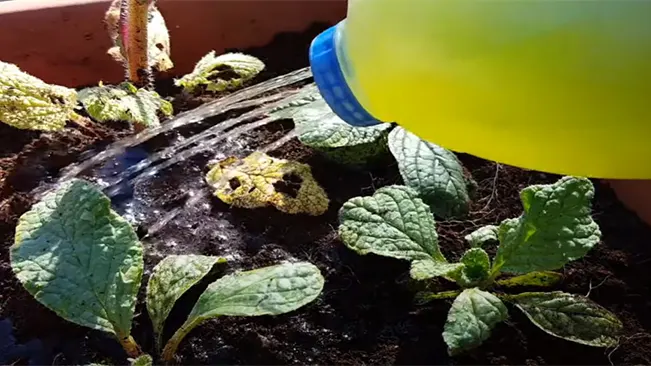
Guidelines for Watering Borage
- Frequency: The frequency of watering borage depends on several factors, including climate, weather conditions, and soil type. In general, watering once or twice a week should suffice. In hotter, drier climates, or during prolonged dry spells, more frequent watering may be necessary.
- Amount: When watering, aim to moisten the soil to a depth of about an inch. This encourages deep root growth, enhancing the plant’s drought tolerance. Use a watering can or hose with a gentle spray to avoid disturbing the soil or damaging the plants.
- Time of Day: The best time to water borage is in the morning. This allows the water to reach the roots before the heat of the day and helps prevent fungal diseases by allowing the foliage to dry out during the day.
- Checking Soil Moisture: Before watering, check the soil moisture. Stick your finger about an inch into the soil. If it feels dry at that depth, it’s time to water. Over time, you’ll get a sense of your borage’s watering needs based on the feel of the soil.
- Watering Method: Drip irrigation or soaker hoses are ideal for watering borage, as they deliver water directly to the roots, minimizing water wastage and preventing leaf wetness, which can lead to disease. If using overhead watering, do so carefully to avoid waterlogging the soil.
Avoiding Common Watering Issues
- Overwatering: Borage is susceptible to root rot if the soil stays waterlogged. Overwatering can be more harmful than under-watering. Ensure good drainage in the soil to prevent water from pooling around the roots.
- Underwatering: While borage is somewhat drought-tolerant, prolonged dryness can stress the plant, leading to poor growth and reduced flowering. Regular watering during dry periods is essential.
Feeding
Borage is a light feeder and does not require much fertilizer. However, a mid-season feeding with a balanced, all-purpose fertilizer can boost growth.
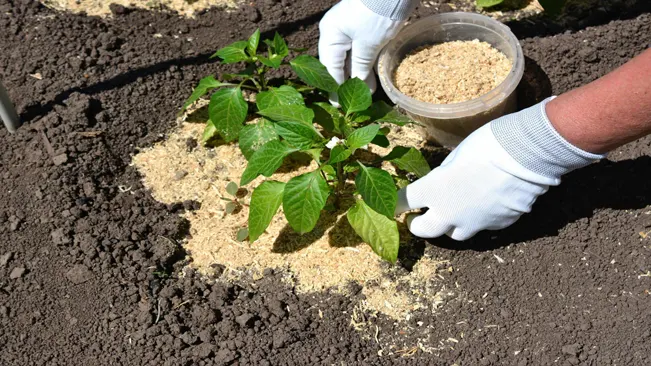
When and How to Fertilize Borage
- Timing: The best time to feed borage is mid-season, usually a few weeks after it has established itself and begun to grow actively. This is typically in late spring or early summer.
- Type of Fertilizer: Use a balanced, all-purpose fertilizer. Balanced fertilizers have equal proportions of the three primary nutrients: nitrogen (N), phosphorus (P), and potassium (K), often labeled as N-P-K 10-10-10 or 20-20-20.
- Application Method: Follow the instructions on the fertilizer package for application rates. Generally, you can sprinkle the granular fertilizer around the base of the plant and then water it in. Liquid fertilizers can also be used and are applied by mixing them with water and watering the plants with the solution.
- Avoid Over-fertilizing: Since borage is a light feeder, it’s crucial to avoid over-fertilizing, which can lead to excessive leaf growth at the expense of flowers, and can also make the plant more susceptible to pests and diseases.
Benefits of Proper Feeding
- Enhanced Growth: Proper feeding can promote more vigorous growth, leading to healthier plants.
- Better Flowering: Adequate nutrients can encourage borage to produce more of its beautiful blue flowers, which are not only attractive but also beneficial for attracting pollinators like bees.
- Improved Flavor and Aroma: In culinary uses, well-nourished borage plants tend to have better flavor and aroma, especially in their leaves, which are often used in salads and drinks.
Organic Alternatives
- For gardeners preferring organic gardening practices, compost or well-rotted manure can be a good alternative to commercial fertilizers. These organic materials release nutrients slowly, improving soil structure and promoting healthy plant growth.
Pruning and Maintenance
Borage, known for its rapid and robust growth, can reach heights of 2-3 feet. This vigorous growth can sometimes result in leggy or sparse plants. Pruning and maintenance are key to managing its size and encouraging a fuller, more attractive shape.
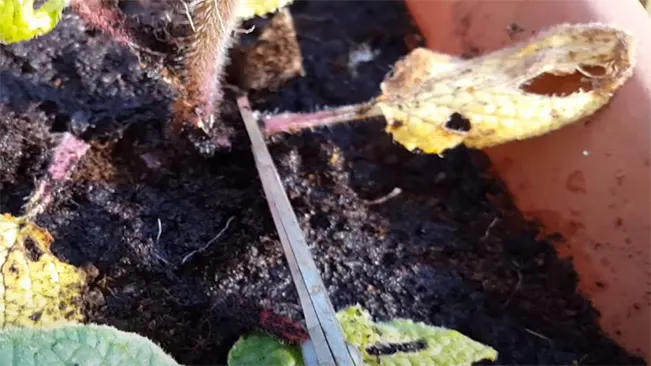
Pinching for Bushier Growth
- When to Pinch: The best time to pinch borage is when the plant has reached a height of about 6-12 inches. At this stage, it is young enough to respond well to pruning.
- How to Pinch: Using your fingers, simply pinch off the tip of the main stem, removing the top few leaves. This action encourages the plant to branch out from the sides, leading to a bushier appearance.
- Frequency: You may need to repeat this process if the plant continues to grow tall without branching. However, avoid excessive pinching as it can stress the plant.
Deadheading for More Blooms
- Removing Spent Flowers: Deadheading, or removing spent flowers, can prolong the blooming period of borage. As the flowers fade, snip them off or pinch them out.
- Stimulating New Growth: Deadheading not only tidies up the plant but also stimulates it to produce more flowers. Since borage flowers are attractive to pollinators, keeping the plant in bloom is beneficial for the garden ecosystem.
- Caution with Seeds: If you want borage to self-seed for next year, leave some flowers to develop into seed pods.
Pest and Disease Control
Borage is generally resistant to pests and diseases. However, keep an eye out for common garden pests like aphids. Neem oil or insecticidal soap can be used to control these pests if necessary.
Pest Control
- Aphids: These small, sap-sucking insects are among the most common pests that can trouble borage. They tend to cluster on the underside of leaves and on new growth. Aphids can cause leaf distortion and can also transmit viruses.Control: To manage aphids, you can:
- Spray water forcefully to dislodge them from the plants.
- Use insecticidal soaps or neem oil, which are effective and less harmful to beneficial insects.
- Encourage natural predators like ladybugs, lacewings, and hoverflies, which feed on aphids.
- Caterpillars and Slugs: Occasionally, borage may attract caterpillars and slugs, especially if it’s grown in a very lush, green state.Control:
- Handpick caterpillars and slugs off the plants.
- Use environmentally friendly slug baits or barriers, like diatomaceous earth, around the base of plants.
Disease Control
- Powdery Mildew: This is a common fungal disease that appears as a white powdery deposit over the leaf surface and affects the plant’s vitality.Control:
- Ensure good air circulation around plants.
- Avoid overhead watering to keep foliage dry.
- Use a fungicide if necessary, following the manufacturer’s instructions.
- Root Rot: Overwatering can lead to root rot, especially in poorly drained soils.Control:
- Ensure the soil is well-draining.
- Water the plants deeply but infrequently to encourage strong root growth.
Harvesting
Borage leaves and flowers can be harvested throughout the growing season. The young leaves have a milder flavor and are excellent in salads, soups, and drinks. The star-shaped flowers are edible too and make a beautiful garnish.
When to Harvest
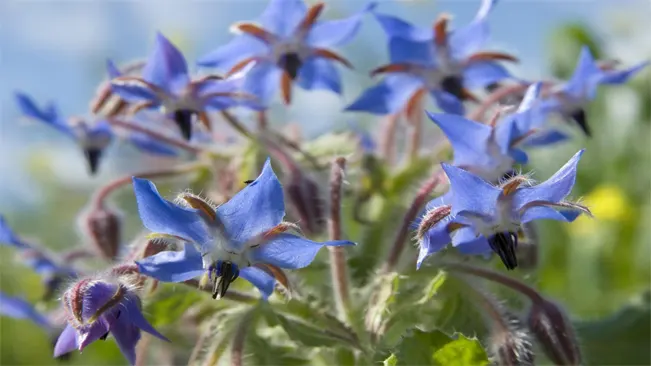
- Borage can be harvested anytime during the growing season, which typically spans from late spring to early fall. The leaves and flowers can be picked as soon as they are large enough to use. The best time of day for harvesting is in the morning after the dew has dried, as this is when the plants are most fresh.
Harvesting Leaves
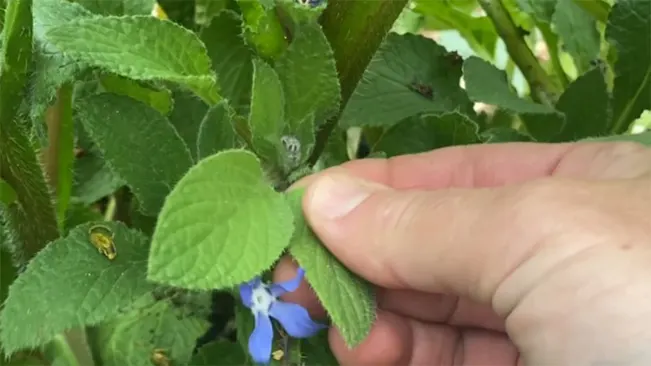
- Young Leaves: The leaves of borage are at their most tender and flavorful when they are young. They have a subtle cucumber-like taste. To harvest, simply pick the young leaves from the top of the plant. Regular harvesting of the leaves encourages the plant to produce more.
- Mature Leaves: As the leaves mature, they become rougher and more prickly. While still edible, they might not be as pleasant to eat raw but can be cooked, which softens them.
Harvesting Flowers
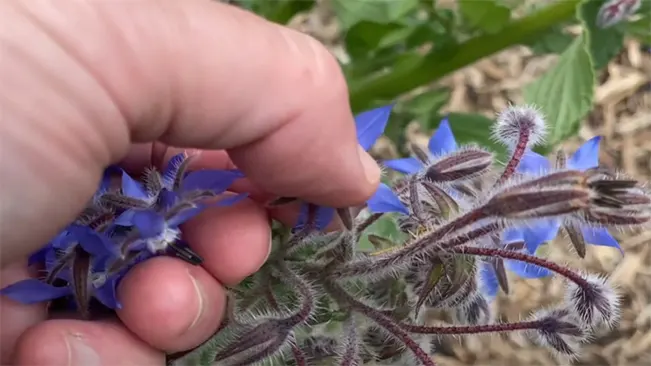
- Edible Flowers: The striking blue, star-shaped flowers of borage are not only beautiful but also edible. They have a slightly sweet, honey-like flavor.
- Method: To harvest, gently pick the flowers off the plant. It’s best to use them soon after harvesting, as they lose their vibrant color and crispness quickly.
- Uses: Borage flowers are perfect for garnishing salads, desserts, and drinks. They can also be frozen in ice cubes to add a decorative touch to beverages.
Tips for Harvesting
- Gentle Handling: Borage is somewhat delicate, so handle it gently when harvesting to prevent bruising.
- Continuous Harvest: Regularly picking leaves and flowers encourages the plant to produce more. However, it’s good to leave some flowers for the bees and for the plant to set seeds.
- Washing: Wash the leaves and flowers gently under cool running water to remove any dirt or insects. Pat them dry before using.
- Storing: Borage does not store well for long periods. Use it fresh, or if you need to store it, wrap it in a damp paper towel and place it in the refrigerator for a short time.
Preservation
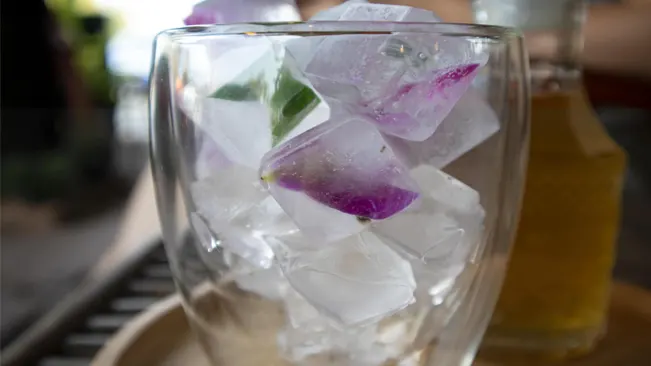
- Drying: While drying is an option, it can diminish the flavor and color of borage, especially the flowers.
- Freezing: Freezing the flowers in ice cubes is a popular way to preserve their beauty and flavor for use in cold drinks.
Benefits in the Garden
Borage is known as a great companion plant. It attracts beneficial insects, particularly bees and predatory wasps. Additionally, borage is believed to improve the growth and flavor of strawberries and tomatoes when planted nearby.
Attraction of Beneficial Insects
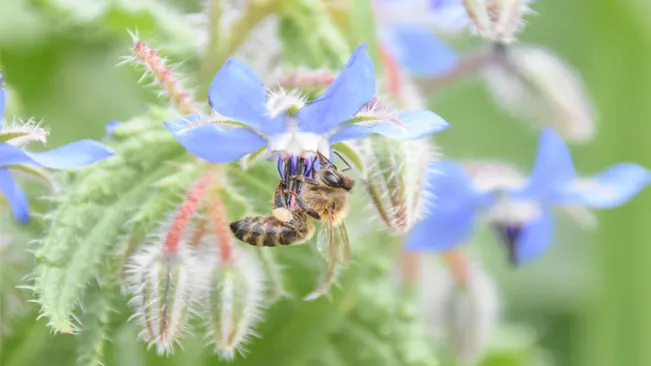
- Bees and Pollinators: Borage is particularly attractive to bees, including honeybees and bumblebees. Its abundant, nectar-rich flowers provide a valuable food source for these pollinators. The presence of bees not only benefits borage but also enhances the pollination of other plants in the garden, leading to better yields of fruits and vegetables.
- Predatory Wasps: Besides bees, borage also attracts predatory wasps. These wasps are beneficial because they feed on common garden pests like caterpillars and aphids, acting as a natural pest control method. This helps reduce the need for chemical pesticides in the garden.
Impact on Neighboring Plants
- Growth and Flavor Enhancement: Anecdotal evidence and some gardeners’ experiences suggest that borage can positively impact the growth and flavor of certain plants, particularly strawberries and tomatoes. The exact mechanism is not well-understood, but it’s believed that borage may improve soil nutrients or provide protection against certain pests, thereby benefiting these plants.
- Trap Cropping: Borage can act as a trap crop for certain pests. This means it can lure pests away from more valuable crops. For instance, borage can attract tomato hornworms, thereby reducing their population on nearby tomato plants.
Soil Health
- Soil Improvement: Borage, with its deep roots, can help in aerating the soil and bringing up nutrients from deeper layers, making them available to plants with shallower roots. This natural process of soil improvement can enhance the overall health of your garden.
- Adding Organic Matter: Once a borage plant completes its lifecycle, it can be left to decompose in the soil, adding organic matter and nutrients, which further enhances soil quality.
Additional Benefits
- Aesthetic Value: Borage adds beauty to the garden with its striking blue flowers, creating an appealing environment for both the gardener and local wildlife.
- Culinary Uses: Beyond its gardening benefits, borage leaves and flowers are edible, offering a cucumber-like flavor to salads, drinks, and other dishes.
Conclusion
Growing borage is a rewarding endeavor for any gardener. Its ease of care, beneficial properties, and culinary uses make it a must-have in any herb garden. By following these simple steps, you can enjoy the beauty and benefits of borage all season long.
FAQs (Frequently Asked Questions)
- What is the best time to plant borage?
Plant borage seeds in late spring or early summer, after the last frost has passed. Borage prefers warmer soil for germination. - How much sunlight does borage need?
Borage thrives in full sun but can tolerate partial shade. Ideally, it should receive at least 6 hours of sunlight daily. - What type of soil is suitable for borage?
Borage grows best in well-drained soil rich in organic matter. It’s not too picky about soil pH but prefers a neutral to slightly acidic range. - How often should I water borage?
Water borage regularly to keep the soil consistently moist, especially in dry conditions. However, be careful not to overwater, as this can lead to root rot. - Does borage need a lot of space to grow?
Space borage plants about 12 inches apart. They can grow up to 2-3 feet tall and spread out, so they need room to flourish. - Can I grow borage in containers?
Yes, borage can be grown in containers. Ensure the container is large enough to accommodate its root system and has adequate drainage holes. - What pests and diseases affect borage?
Borage is relatively pest and disease-resistant. However, watch for aphids and use an appropriate organic insecticide if necessary. - When and how do I harvest borage?
Harvest borage leaves and flowers as needed throughout the growing season. Young leaves have a milder flavor, and the star-shaped flowers are edible. - Can borage be used as a companion plant?
Absolutely! Borage is an excellent companion plant, attracting bees and beneficial insects. It’s believed to improve the growth and flavor of strawberries and tomatoes. - How do I save borage seeds for next year?
Allow some of the flowers to mature and form seed pods. Once the pods dry and turn brown, collect them and store the seeds in a cool, dry place for planting next year.
For more expert gardening advice, explore our guides, discover top recommendations in our best section, and delve into in-depth product reviews in our review section.

Kristine Moore
Forestry AuthorI'm Kristine Moore, a seasoned garden landscaping professional with over 30 years of experience. My extensive career has been dedicated to transforming outdoor spaces into stunning, sustainable landscapes. With a deep understanding of horticulture, design principles, and environmental stewardship, I have become a respected figure in the field, known for creating harmonious, visually appealing, and eco-friendly gardens. My commitment to excellence and continuous learning in landscaping trends and techniques has solidified my reputation as an expert in garden design and implementation.

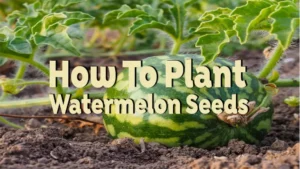

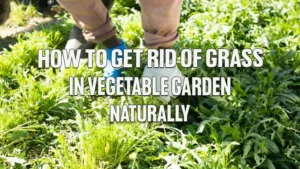



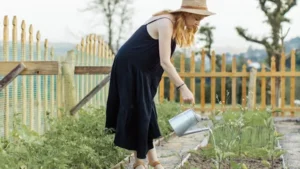


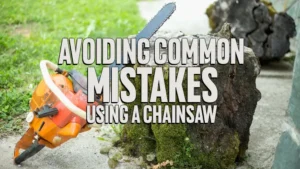


Leave your comment